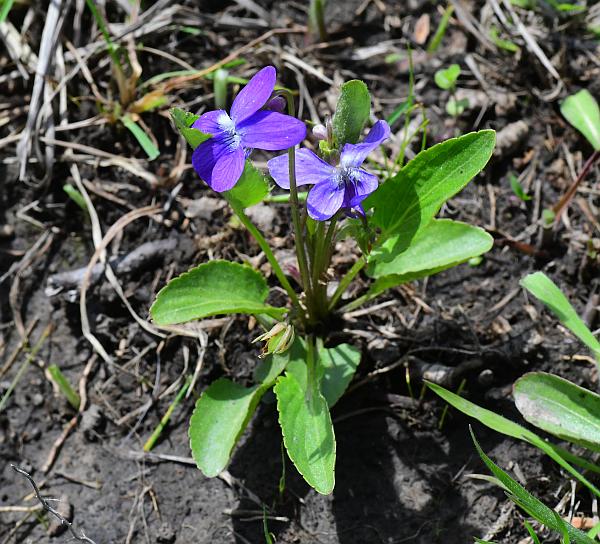Viola sagittata Aiton
Arrow-Leaved Violet

Native
CC = 6
CW = 0
MOC = 49
© SRTurner
Viola sagittata AitonArrow-Leaved Violet | |
 |
Native CC = 6 CW = 0 MOC = 49 |
© SRTurner |
|
Family - Violaceae Habit - Perennial forb to 30 cm tall, with a prostrate to ascending rhizome 4-6 mm thick. Stem - Aerial stem absent. Flowers and leaves arise directly from underground rhizome.
Leaves - In a basal rosette, long-petiolate, the petiole glabrous or finely hairy. Stipules conspicuous, free from the petiole, membranous to somewhat herbaceous, narrowly lanceolate, the margins toothed and glandular-hairy. Leaf blades 1.5-8.5 cm long, all except sometimes those of the first leaves of the growing season lobed (occasionally appearing only coarsely toothed), the lobes produced only near the blade base and less than 1/3 the length of the midvein, the blade much longer than wide, elliptic to narrowly triangular, narrowly angled to a rounded to sharply pointed tip, broadly rounded to truncate or cordate at the base, the margins otherwise bluntly toothed below an often more or less entire apical portion, the surfaces glabrous or finely hairy.
Inflorescence - Flower stalks arising from rhizome, not or only slightly overtopping the leaves (those of the cleistogamous flowers erect or ascending).
Flowers - Sepals 4-8 mm long, lanceolate, narrowly angled to a sharply pointed tip, the margins sometimes minutely hairy, the basal auricles well-developed, elongating as the fruits develop. Corollas 8-14 mm long (except in cleistogamous flowers), the petals oriented forward with arched or outward-curved apical portions, longer than the sepals, bluish purple to purple (with a greenish white throat) with darker veins (rarely all white elsewhere), the lateral and lower petals bearded on the upper surface with slender hairs, the spur conspicuous, well-exserted beyond the sepal auricles, stout and often somewhat hemispheric in shape. Stamens not exserted, typically not visible without dissection of the flower. Style slender, slightly expanded into a narrow, more or less scoop-shaped, hollow, truncate tip. Cleistogamous flowers produced.
Fruits - Capsules 11-18 mm long, narrowly ellipsoid to ellipsoid, green, drying to tan, the surface glabrous. Seeds 1.2-1.5 mm long, tan to brown. Flowering - April - June. Habitat - Prairies, sandstone glades, openings of oak forests, on dry to seasonally somewhat moist sand or gravelly sand. Origin - Native to the U.S. Lookalikes - Other species of Viola. Other info. - This small violet is fairly common in most parts of Missouri except for the northwestern corner of the state. It also occurs across the eastern half of the continental U.S. and into Canada. Though widespread in distribution, it is apparently not very abundant in most places. It is also sometimes overlooked, as it is typically rather small, and the flowers look the same as those of other, more common species of violet. Beyond being recognized as a violet by the characteristic flowers, the species is identified by its relatively long, narrow leaves which usually have a few irregular teeth or shallow lobes near the base. The plant produces no aerial stem; instead, the flower and leaf stalks arise from an underground rhizome. Photographs taken near Ironton, Iron County, MO, 5-16-2017, and at Tucker Prairie Natural Area, Callaway County, MO, 5-1-2020 (SRTurner). |